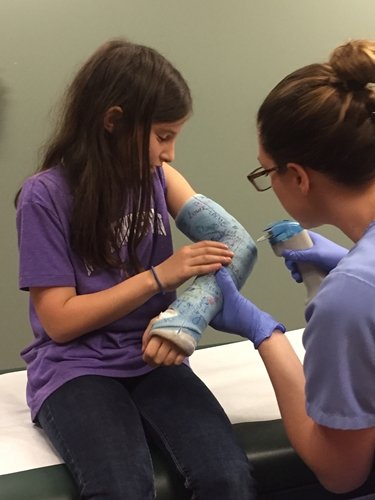
Take care of your child's cast with these tips.
A broken bone is practically a childhood rite of passage. Whether it occurred as the result of a fall from a tree fort or a miscalculated trick on a bike, it's an injury that happens in an instant, but can take weeks – or even months – to heal. During that time, one of your largest challenges as a parent will be taking care of the cast to ensure the injury remains protected as it mends.
If your child broke a bone, follow these five tips – as well as any instructions from your health care provider – to keep the cast in good condition.
1. Keep it clean
The first step to maintaining a cast is to keep it clean. But depending on the age of your child, even this simple task may present a challenge. Little ones will likely need extra attention to ensure they don't collect food, dirt and other grime while they're healing. For example, you might find it helpful to cover the cast with something during meals or other times when it could be exposed to spills from the table. Try to avoid situations where it could collect dust or dirt as well. The cast will probably be on for a number of weeks, so rolling around playing somewhere it will become covered in sweat and dirt is less than ideal. Not only will the cast look dirty, but it might start to smell bad as well.
2. Avoid powders and lotions
While casts are important for ensuring that the broken bone or bones heal properly, they aren't necessarily always comfortable. It may be tempting to use some kind of cream or salve to ease itching or other discomfort, but, according to Mayo Clinic, powders, lotions and deodorant should not be used on – or even near – the cast.
If itchiness is a problem, pass on the powders and lotions and pull out a hairdryer instead and blow cool air under the cast.

3. Seek professional assistance for adjustments
Though you play an important role in taking care of your child's cast, you shouldn't always be the one to fix problems during the recovery period. If your child's cast needs to be adjusted or develops a crack or soft spot, get help from a medical provider. Though it may be tempting to make little fixes yourself, you run the risk of damaging the cast or even exacerbating your child's injury.
According to the American Academy of Orthopaedic Surgeons, signs you should contact the doctor include:
- Increased pain and a feeling of tightness.
- Inability to move fingers or toes.
- Significant swelling below the cast.
- Burning or stinging of the skin.
- Tingling or numbness in the hands or feet.
These symptoms could signify a problem that should be assessed by a provider as soon as possible.
4. Dry it immediately if it gets wet
Even if your child knows not to jump into the pool until the cast comes off, there still could be some accidents that involve water while the bone heals. If the cast becomes damp, it's important to dry it off as quickly as possible, as moisture can weaken the plaster and dampen the padding, causing irritation to the skin. You can use a hair dryer on a low, cool setting to eliminate any moisture.
If the cast is fiberglass, a small amount of water may not be a problem. However, you should always talk to the doctor to be sure and follow any care instructions you're given.
5. Stay dry with SEAL-TIGHT®
Though it's possible to dry a cast, it's easier to just avoid it getting wet in the first place. SEAL-TIGHT® Original Cast and Bandage Protector's pediatric models are specifically designed to keep your child's cast dry during showers and baths. The nonlatex diaphragm is easy to stretch over the cast – no straps or hooks necessary – and forms a watertight seal that provides the best possible protection from moisture. When bathtime rolls around, simply apply the protector and rest easy knowing your child can enjoy a normal bath or shower routine without damaging the cast.
